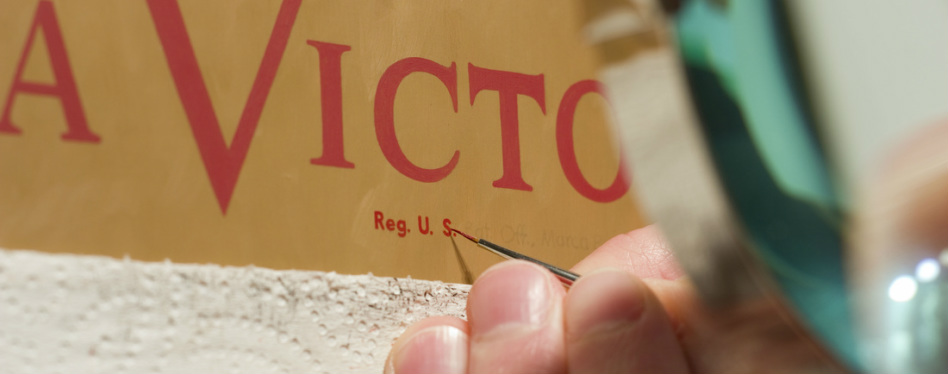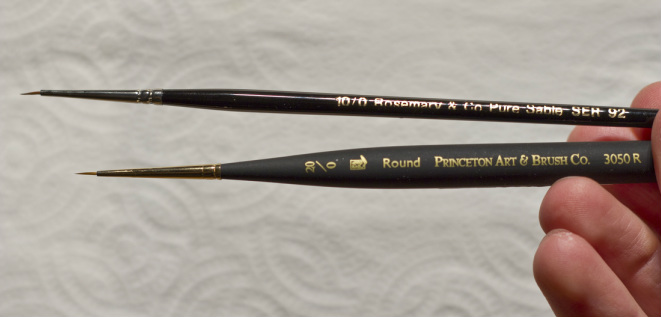Painting Small
Painting small requires small brushes and a very steady hand. A popular rule in painting is to use the largest brush possible for any particular area. While much of the work can be accomplished with larger brushes, to take the art to the next level, miniature brushes are needed. Miniature brushes are usually very small rounds made from tuffs of sable hair, a sable-like synthetic, or both.
|
The best manufacturers I've tried for these specialty brushes are Princeton and Rosemary & Co.
Princeton's 3050 line of brushes come in a variety of shapes and sizes but I favor the 20/0 round. Its the smallest round they make and it retains a sharp point as well as a tiny brush can. I believe they are made from a synthetic fiber. This brush is a bit of a workhorse for me as I use it for just about all details and lettering. They are usually only available online at art stores like Dick Blick. The price for these are from $4 - $6. Rosemary & Co is small family business in the U.K. who deal directly with the artists. They cut out the retail shop which allows them to price their products very competitively. The |
miniature brushes they offer, the Series 92, are made from pure red sable, which is a bit softer compared to the Princeton. Their smallest is 10/0, about the same size as Princeton's 20/0. They go for about $3.
|
|
The miniature brushes unfortunately can be difficult to use and will fight you every step of the way. Perfectly made brushes are rare as well; they don't always like to form a single sharp tip. I've gotten in the habit of trimming away stubborn hairs that just will not behave.
Another common problem is fraying - you reshape the brush after cleaning it and the hairs dry splayed out. One tip I found that fixes this problem is using a bit of spit or saliva to shape the brush after soap and water. Sounds gross, but since I started using salvia, the brushes dry to a nice sharp point and stay that way for the most part during painting. I even have a book written by Harold Speed in 1873 where he writes, "After washing in soap and water they should be thoroughly rinsed and dried, and then lovingly sucked to bring the hairs together." According to Wikipedia, human saliva is 99.5% water, while the other 0.5% consists of electrolytes, mucus, glycoproteins, enzymes, and antibacterial compounds. I assume something in the other 0.5%, probably mucus, helps the brush keep it's shape while drying, sort of like a hair gel. |
|
However, saliva will not repair a damaged brush, but it does help maintain well taken care of brushes that are thoroughly cleaned after each painting session. I also cannot recommend putting brushes directly in your mouth as Harold Speed insists since they come in contact with heavy metals and toxic pigments.
Another tool that aids painting small is a magnifying glass. I frequently use one for lettering and tiny details. The particular kind I have has a flexible gooseneck and clamp. These can be found on ebay or amazon for a reasonable price by searching "gooseneck magnifier". The last bit of advice I can offer for painting small is to work on smooth panels or very fine portrait canvas or linen. When using small brushes such as the 20/0, the physical surface of your support will influence how you paint. Its much easier to control a miniature brush on a smooth panel than a coarse canvas because it is free of textures such as the weave. Trying to paint small on rough surfaces can be a nightmare.
|
|



